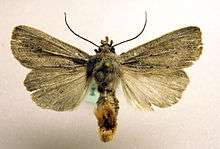Protarchanara brevilinea
Protarchanara brevilinea, or Fenn's wainscot, is a moth of the family Noctuidae. The species was first described by Charles Fenn of Lewisham who collected specimens during an entomological excursion to Ranworth in 1864.[1] It is found in western and northern Europe.
| Protarchanara brevilinea | |
|---|---|
 | |
| Scientific classification | |
| Kingdom: | |
| Phylum: | |
| Class: | |
| Order: | |
| Family: | |
| Genus: | |
| Species: | P. brevilinea |
| Binomial name | |
| Protarchanara brevilinea (Fenn, 1864) | |
| Synonyms | |
| |
Technical description and variation
A. brevilinea Fenn (49 d). Forewing dull grey brown densely black-dusted; the veins terminally paler; inner and outer lines represented by a series of dark vein dots; a black streak from base below cell: hindwing fuscous, darker towards termen; an outer row of dark dots; the ab. sinelinea Farn (49 d) is more uniform in coloration, without the black streak from base. Larva pale ochreous, with brown freckling; dorsal, subdorsal, and spiracular lines orange edged with yellow; head pale brown.[2]The length of the forewings is 14–17 mm.
Biology
The moth flies in one generation from mid-July to August..
The larvae feed on Phragmites living within the stems and when young feeding there; afterwards emerging from the stems by night and feeding on the leaves.
Notes
- ^ The flight season refers to the Netherlands. This may vary in other parts of the range.
References
- Savela, Markku. "Protarchanara brevilinea (Fenn, 1864)". Lepidoptera and Some Other Life Forms. Retrieved July 5, 2019.
- Warren. W. in Seitz, A. Ed., 1914 Die Großschmetterlinge der Erde, Verlag Alfred Kernen, Stuttgart Band 3: Abt. 1, Die Großschmetterlinge des palaearktischen Faunengebietes, Die palaearktischen eulenartigen Nachtfalter, 1914

| Wikimedia Commons has media related to Protarchanara brevilinea. |
- Kimber, Ian. "73.150 BF2351 Fenn's Wainscot Protarchanara brevilinea (Fenn, 1864)". UKMoths. Retrieved 4 July 2019.
- Fauna Europaea
- Lepiforum e.V.
- De Vlinderstichting (in Dutch)